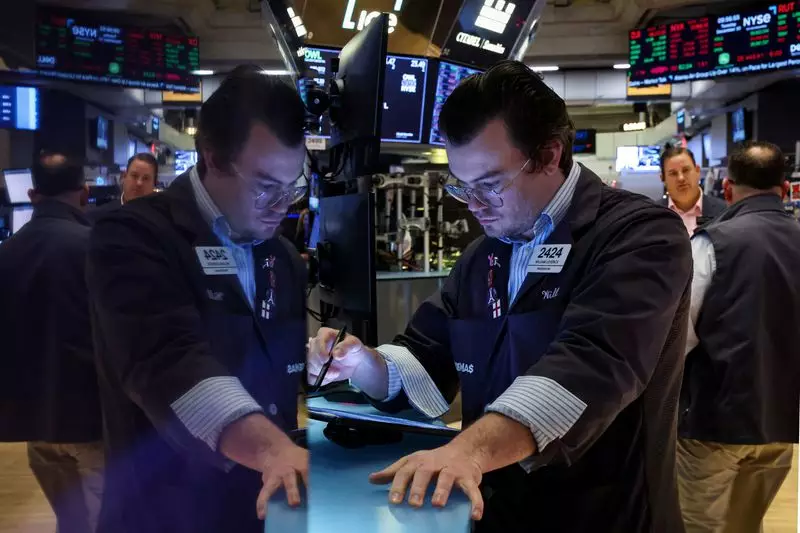In a notable turn of events, Wall Street’s primary stock indexes experienced significant gains on Friday, with the tech-heavy Nasdaq leading the charge. The driving force behind this impressive upward movement can be traced back to an optimistic earnings forecast from Broadcom, the semiconductor giant. Anticipation surrounding artificial intelligence (AI) continues to captivate investors, as Broadcom projected quarterly revenues that surpass Wall Street expectations, highlighting a burgeoning demand for their specialized AI chips. This bullish outlook spurred Broadcom’s shares to soar by over 21%, simultaneously allowing the company to cross the $1 trillion mark in market capitalization for the very first time.
Peter Andersen, the founder of Andersen Capital Management, connected the dots between Broadcom’s stellar performance and the broader surge in investor excitement, emphasizing that AI represents one of the most dynamic sectors in the market today. He remarked, “The stock rally is an aspect of this over-enthusiasm for the sector.” The implications of such enthusiasm are multifaceted, as investors look increasingly towards tech and semiconductor sectors for potential gains.
The ripples from Broadcom’s forecast extended to other technology and semiconductor stocks, notably with Marvell Technology, which enjoyed a gain of 9.5%. An index tracking semiconductor stocks overall climbed by 3.7%. Despite this tech surge, it is worth noting that the broader S&P 500 index saw seven of its eleven sectors trading lower on that same day. However, the 1% increase in the information technology sector provided a crucial counterbalance to broader losses.
Meanwhile, the Nasdaq Composite had recently breached the 20,000 mark for the first time on Wednesday, driven by a consistent rally in technology stocks. Federal Reserve indicators showed that traders have priced in a near-certainty—over 96%—for a 25-basis-point rate cut during the upcoming Federal Reserve meeting. This anticipated monetary easing has contributed to exuberance in the markets, despite some dissenting opinions regarding the prudence of immediate cuts.
Ermengarde Jabir, the director of economic research at Moody’s, expressed caution about the Federal Reserve’s potential decision. She alluded to recent economic indicators, including Consumer Price Index (CPI) and Personal Consumption Expenditure (PCE) data, suggesting that a rush toward monetary easing may not align with long-term strategic goals.
As markets navigate these ebbs and flows, the Dow Jones Industrial Average reflected a modest gain earlier in the day, climbing by 86.21 points to rest at 44,000.33. The S&P 500 gained 23.14 points, reaching 6,074.39, while the Nasdaq Composite ascended by 129.18 points, arriving at 20,030.82. Despite a brief pause in trading the previous session, when economic data sparked concern over potential Fed actions, investor sentiment remains buoyant.
The remarkable rise in U.S. stocks this year has been characterized by persistent climbs to all-time highs, as investors gravitate toward heavyweight tech companies with the promise of AI. This market behavior reflects a tendency to seek out opportunities that offer significant potential for growth. Adding another layer, the political landscape—specifically, Donald Trump’s presidential victory—has led to increased confidence among market participants, who anticipate that business-friendly policies may enhance corporate profitability.
While many stocks are thriving, not every company is experiencing the same level of success. Salesforce, for instance, managed a modest increase of 1.4% following an upgrade from KeyBanc, which shifted its rating to “overweight.” In contrast, RH (formerly Restoration Hardware) experienced a remarkable surge of 14.5% after reporting heightened net revenue for the third quarter, illustrating that individual company performance can greatly influence stock trends.
However, the broader market shows signs of a mixed environment as declining issues outnumbered advancers, both on the NYSE and Nasdaq exchanges. The S&P 500 reported six new 52-week highs alongside 14 new lows, while the Nasdaq Composite recorded 32 new highs and 74 new lows. This distribution indicates a market that, while buoyed by several strong performers, is grappling with underlying volatility and profit-taking trends as investors evaluate their positions in this dynamic and speculative trading landscape.
Wall Street’s current bullish sentiment—fueled heavily by AI advancements and significant corporate earnings projections—presents a fascinating juxtaposition of enthusiasm and caution. While technology stocks dominate the headlines, ongoing scrutiny of economic indicators and monetary policies will remain critical as investors seek to navigate the complexities of today’s financial environment.

